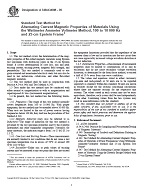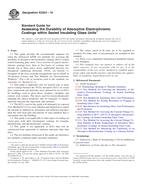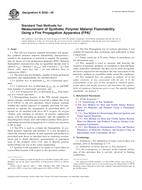1.1 This test method covers quantitative procedures for the evaluation of the compatibility of automotive engine oils with five reference elastomers typical of those used in the sealing materials in contact with these oils. Compatibility is evaluated by determining the changes in volume, Durometer A hardness and tensile properties when the elastomer specimens are immersed in the oil for a specified time and temperature.
1.2 Effective sealing action requires that the physical properties of elastomers used for any seal have a high level of resistance to the liquid or oil in which they are immersed. When such a high level of resistance exists, the elastomer is said to be compatible with the liquid or oil.
Note 1 – The user of this test method should be proficient in the use of Test Methods D 412 (tensile properties), D 471 (effect of rubber immersion in liquids), D 2240 (Durometer hardness), and D 5662 (gear oil compatibility with typical oil seal elastomers), all of which are involved in the execution of the operations of this test method.
1.3 This test method provides a preliminary or first order evaluation of oil/elastomer compatibility only. Because seals may be subjected to static or dynamic loads, or both, and they may operate over a range of conditions, a complete evaluation of the potential sealing performance of any elastomer-oil combination in any service condition usually requires tests additional to those described in this test method.
1.4 The five reference elastomer formulations specified in this test method were chosen to be representative of those used in heavy-duty diesel engines. The procedures described in this test method can, however, also be used to evaluate the compatibility of automotive engine oils with different elastomer types/formulations or different test durations and temperatures to those employed in this test method.
Note 2 – In such cases, the precision and bias statement in Section 12 does not apply. In addition to agreeing acceptable limits of precision, where relevant, the user and supplier should also agree: (1) test temperatures and immersion times to be used; (2) the formulations and typical properties of the elastomers; and (3) the sourcing and quality control of the elastomer sheets.
Note 3 – The TMC may also issue Information Letters on this matter.
1.5 The values stated in SI units are to be regarded as standard. No other units of measurement are included in this standard.
1.6 This standard does not purport to address all of the safety concerns, if any, associated with its use. It is the responsibility of the user of this standard to establish appropriate safety and health practices and determine the applicability of regulatory limitations prior to use.
1.7 This test method is arranged as follows:
| Section | |
|---|---|
| Scope | 1 |
| Referenced Documents | 2 |
| Terminology | 3 |
| Summary of Test Method | 4 |
| Significance and Use | 5 |
| Apparatus | 6 |
| Reference Materials | 7 |
| Procedure | 8 |
| Calculations | 9 |
| TMC 1006-1 Reference Oil | 10 |
| Report | 11 |
| Precision and Bias | 12 |
| Keywords | 13 |
| Formulations and Physical Properties for the Reference Elastomers | Annex A1 |
Product Details
- Published:
- 12/01/2008
- Number of Pages:
- 9
- File Size:
- 1 file , 140 KB
- Redline File Size:
- 2 files , 240 KB


